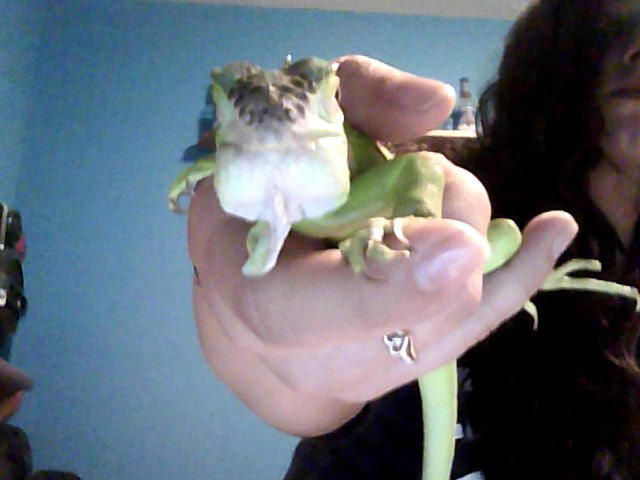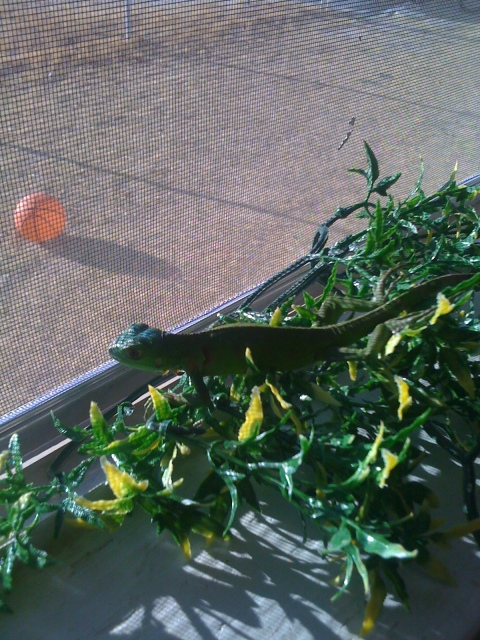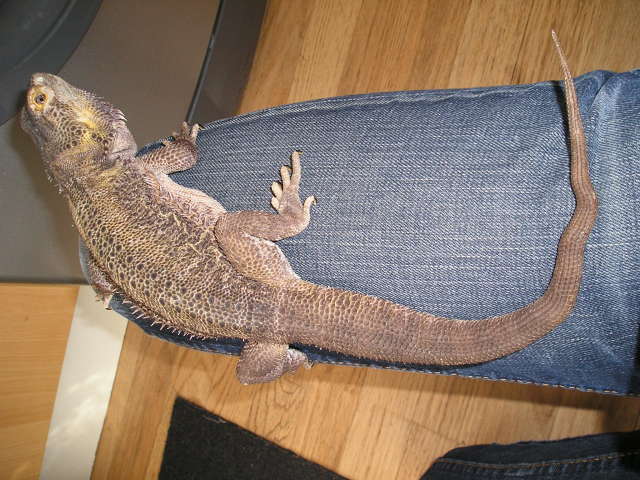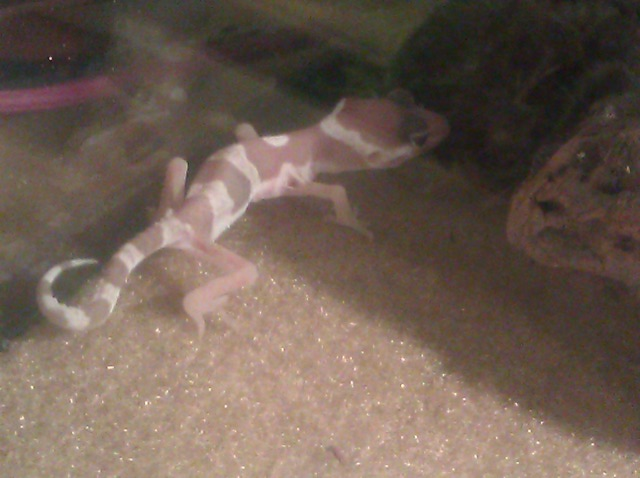QuestionHello. I'm the person who just got the gecko. I told you in my last question that he seems kind of slow. Well, I'm starting to think he's sick. He's dreadfully afraid of my hand, and I expected that, but he doesn't move that far. He's been sitting in the same spot in his cage all day yesterday, this morning when I woke and this afternoon when I got home from school. Even now he's in the exact same spot. The day I got him, I was supposed to get food because I didn't want to get anything that would die too quickly before I had him. I was so excited in getting him, I guess, I forgot to get him food. I haven't gotten any until today. Is that why he seems so lethargic? He still hasn't moved, even though I put two crickets in there to see how he would respond. Will he be all right? Should I have gotten an adult? I'm really worried now. Of all my animals, only two of my reptiles have died before their due, and that was because of a cage problem and they lived together. I've been so careful about it since then. The spot he's in isn't even in a hide. He's by the log in the back of his cage. Please reply soon.
-Cristan
AnswerHi Cristan,
I'm not a fan of getting baby reptiles as there is generally a lot more problems with eating, etc.
I'm guessing he is laying in the cool end of the cage.... that usually means one of two things...he is sick and is seeking cooler temperatures or the other area is too hot for him.
I'm going to include a basic care sheet that I wrote so you can see more on temperatures, etc.
With babies, they eat at least once or even twice(possibly more) a day. Also, the insects need to be gut loaded prior to feeding to the leo so that the insect is nutritious. That gel type stuff is not a proper gut load for insects.
Is he housed by himself? If not, I suggest giving him his own tank and set up. The stress of an older, larger or possibly same sex cage mate will cause huge problems.
He may have internal parasites which a vet is needed to diagnose this.
In all honesty, if all your care is correct, and you are able to return him to the place you got him, I would do so because a healthy baby leo is generally active once the sun goes down since they are nocturnal. Go over all the info in the care sheet below and see if you can spot a problem in his care..if all care is correct, a vet is needed or as I said, return him if its within the time limit for that. You may have to take store credit or a replacement. If they say a replacement, spend some time watching the others and if possible, take a larger/older one that is acting healthy. Its sometimes hard to figure out during the day with lights, etc since they are nocturnal.
With pet store reptiles they really do not get the needed night time hours due to store hours and that alone is a great stress on them.
BASIC CARE FOR A LEOPARD GECKO
Leopards are pretty easy to care for but they do need
special care. Here are some of the basic needs of your gecko.
HOUSING: The need to have at least a 20 gallon long tank for one Leo. This needs to have a secure fitting screen top...they can be quite the escape artists!!! They need to have a humid hide box.You can make this with something as simple as a small plastic dish with a hole cut in one side and a small mesh bag filled with some Sphagnum moss coconut bark or Peat moss that you mist.
I made mine out of the small plastic folgers coffee containers...I cut an opening in the lid..and put the moss in..they LOVE it. I use the terrarium moss in mine.
I use that on the warm side of the tank. Be sure to provide a cool hidebox on the other end. I also provide a mid temperature hide...which is in the middle of the tank.I use the critter caves which you can purchase. NOT the ones that have heat in them!!!!
Provide secure climbing areas for your gecko. Fake plants, rocks and branches are all fine to use. be sure there are no wires or sharp ends to any fake plants you use.
*****SUBSTRATE:(that's the stuff on the floor of your tank) Newspaper, lizard carpet or paper towels work great and are easy to clean and are much safer than any loose substrate. Sand or other loose substrate is not recommended as that they can be deadly to the leo when it is ingested(eaten, even by accident while eating their insects)...A very graphic site of an impacted leo surg can be seen at http://homepage.mac.com/exoticdvm/reptile/PhotoAlbum181.html it is very graphic!!! ******What I have found that works great for safety and heat distribution is using about 1/4 inch of childrens play sand(since the tiles fit tight together, there is no sand danger) on the bottom of the tank and on top that you place ceramic or slate floor tile. What is nice is that the 12 x 12 squares fit perfect in a 20 gallon tank with no spaces between the tiles. The sand and the tile distribute the heat wonderfully. Using the under tank heater as described is what distributes the heat. Also, overhead heat will help in heating the tiles...I've been using this set up for several years and the leos love it. Using a tile that isn't smooth is recommended. **********
TEMPERATURES: They need a warm area ( on the floor) of 88-92 degrees and a
cooler area in the upper 70s, low 80s. At night their temperature can drop to the low to mid 70's.
Never use a hot rock for a leopard gecko...or any reptile.
They can severely burn any reptile. You can use a heating
pad under the tank,under tank heater for the warm area. You can use a regular household lightbulb in a dome fixture with a ceramic socket in it to keep the warm area at the 88-92 degree area if needed there, otherwise, placing the lightbulb about midway in the tank will give the needed temeratures throughout the tank. You may have to play with the wattage of the bulb but generally 40-60 watts is sufficient.At night, no white light. If room temperatures stay above 70 degrees, no extra night heat is needed. The undertank heater or heating pad should cover about 1/3 of the tank....be sure to raise the tank up about 1/4-1/2 inch off the stand when using an undertank heat source to prevent heat build up which can cause the glass to break and hot spots in the glass. Be sure to have a good layer of newspaper, carpeting or, even a thin flat rock(such as tile) on top the area that the undertank heat source is placed...if you use a thin rock or tile, it helps to distribute the heat very well.
You can use the special nighttime lights that are designed for reptiles. I like using a ceramic heat emitter on a thermostat for nighttime heat.
DO NOT use black lights or party lights as they can cause eye damage!!!!
The wattage you use will vary based on room temperature and size of tank.
LIGHTING: Leopard geckos do not need UVB lighting but it does not hurt them to give them uvb. They should have some type of light during the day, be it a uvb tube, regular florescent light, reptile day light or regular household lightbulb. NO white lights at night!!!
FEEDING: Geckos should not be fed crickets or other insects that are bigger than the space between their eyes. Generally, hatchlings can be fed more than once a day,juvys can be fed twice a day, adults are fed once daily or every other day, in the early evening. Crickets and other food items such as silk worms, super, and an occasional treat of a wax worm, need to be dusted with a calcium supplement two times a week and also they should have a small dish of calcium in their tank. I use the lid of a milk jug for the little dish of calcium in their tank. For dusting the insects, Use a calcium with no added phosphorus. Insects must be gut loaded(fed) for at least 48 hours prior to feeding your gecko. Remove any uneaten crix or superworms after 15-20 minutes..... Place a piece of cut potato in the tank so that if you have missed any uneaten insects, they will eat the potato instead of nibbling on your gecko!!!
*************You have to be sure to feed your crickets and insects the right foods before feeding them to your gecko. If your crickets/insects are not healthy and well fed, your gecko will not get the nutrition he needs. You can gut load your crickets and insects greens, veggies, cereals or specially designed commercial foods for crickets or the insects you are feeding. ************
Be sure to have a small dish of clean water for your gecko at all times!!
You can offer them some baby food or fruits on occasion ...
Mine will even eat a small piece of watermelon now and then.WATER: always provide a dish of drinking water. If you choose to mist your gecko to drink, its best to not get the tank too wet as that they do not do well with higher humidity. Sometimes its better to take your leo out of their tank to mist them to get them to drink!!!
HANDLING: Some geckos enjoy being held...others prefer not to be handled at all. Be sure to be very gentle when holding your leo and NEVER grab them by the tail! Their tails are extremely fragile and will break.
I do suggest finding a vet that can treat reptiles BEFORE you actually need one!!! To find a vet that is able to care for reptiles:
http://www.herpvetconnection.com
http://www.arav.org/ECOMARAV/timssnet/amm/tnt_mdsearch.cfm
http://www.anapsid.org/vets/
For more information on leopard geckos:
http://www.drgecko.com
If you have any questions or don't understand something, please let me know.

 Iguana injury
Question
lower jaw bigger
Hi! My name is Megan.
Iguana injury
Question
lower jaw bigger
Hi! My name is Megan.
 Igauana might have MBD
QuestionQUESTION: I have ordered the new light bulb and
Igauana might have MBD
QuestionQUESTION: I have ordered the new light bulb and
 Dragon turning yellow
QuestionQUESTION: I have a 7 year old male, was g
Dragon turning yellow
QuestionQUESTION: I have a 7 year old male, was g
 kink,bend or break in tail
QuestionQUESTION: hi i have a bearded dragon he/she is
kink,bend or break in tail
QuestionQUESTION: hi i have a bearded dragon he/she is
 Little Leo Gecko SICKKK
Question
Leo Gecko Sick
I just recently bo
Little Leo Gecko SICKKK
Question
Leo Gecko Sick
I just recently bo